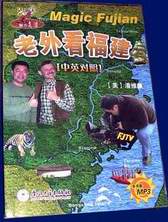![]() Click
to
Access
Click
to
Access
OUTSIDE China
![]() Click
to Access
Click
to Access
INSIDE
China ![]()
TRAVEL LINKS
![]() Xiamen
Xiamen
![]() Gulangyu
Gulangyu
![]() Jimei
Jimei
![]() Tong'an
Tong'an
![]() Jinmen
Jinmen
![]() Zhangzhou
Zhangzhou
![]() Quanzhou
Quanzhou
![]() Wuyi
Wuyi
![]() #1Fujian
Sites!
#1Fujian
Sites!
![]() Fujian
Foto Album
Fujian
Foto Album
![]() Books
on Fujian
Books
on Fujian
![]() Readers'Letters
Readers'Letters
![]() Ningde
Ningde
![]() Zhouning
Zhouning
![]() Longyan
Longyan
![]() Sanming
Sanming
![]() Putian
Putian
![]() Bridges
Bridges
![]() Travel
Info,
Travel
Info,
![]() Hakka
Roundhouses
Hakka
Roundhouses
![]() Travel
Agents
Travel
Agents
MISC. LINKS
![]() Amoy
People!
Amoy
People! ![]()
![]() Darwin
Driving
Darwin
Driving ![]()
![]() Amoy
Tigers
Amoy
Tigers
![]() Chinese
Inventions
Chinese
Inventions
![]() Tibet
in 80 Days!
Tibet
in 80 Days!![]()
![]() Dethroned!
Dethroned!
![]()
![]() Misc.Writings
Misc.Writings
![]() Latest
News
Latest
News
![]() Lord
of Opium
Lord
of Opium
![]() Back
to Main Page
Back
to Main Page
![]() Order
Books
Order
Books![]() Xiamenguide
Forum
Xiamenguide
Forum 

(a birdwatcher's paradise!)
Click Here for Robert Swinhoe's Remarks
on Amoy Flora and Fauna
For the Birds!
Bushwalkers should always carry a pair of
binoculars because Xiamen is heaven for veteran birdwatchers like Mr.
Marc Mueller (a teacher at Xiamen Education College; see photos below
of Marc seeking the rare Woodstockius Peanutsiensis).
Xiamen bird watchers have formed the Observe Birds Association (OBA),
and each March the OBA promotes “Care for Birds Week,” and
offers field trips for bird watchers of all ages. Back in 1860, Mr. Swinhoe,
the British Consul in Amoy, reported 174 kinds of birds on Amoy! I’ll
let Mr. Swinhoe introduce his fowl and fauna, but first a brief intro
to the great naturalist himself.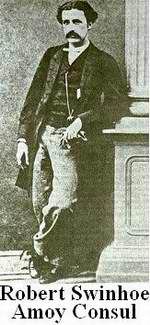
Robert
Swinhoe was born in Calcutta, India on 1 September
1836 to a family who had served British interests in India for many years.
His father was a lawyer and his brother was a colonel in India.
After university in England, Swinhoe went to Hong Kong at age 18, and
studied Chinese, as well as Chinese natural history. He moved to Amoy
in 1855, learned the local dialect, studied the local fowl and fauna,
and kept as pets a civet cat , pangolin , great owl, and a young falcon
. During a trip to Taiwan, he recorded, during only two weeks 93 new birds
and 17 mammals.
Swinhoe returned to Amoy, where he helped found the short-lived Literary
and Scientific Society of Amoy. At their first meeting, on 17 November
1856, Swinhoe read his first published paper, “A Few Remarks on
the Fauna of Amoy.” (I include an edited version of this at the
end of this chapter).
 Swinhoe was the first British consular official in Taiwan. He became ill
and returned to England in 1862, where he set up an award-winning “Formosan
Booth” at the London Exhibition, and gave lectures for many societies.
Charles Darwin, in one of his writings, noted the pigeon skin specimens
sent to him by Swinhoe.
Swinhoe was the first British consular official in Taiwan. He became ill
and returned to England in 1862, where he set up an award-winning “Formosan
Booth” at the London Exhibition, and gave lectures for many societies.
Charles Darwin, in one of his writings, noted the pigeon skin specimens
sent to him by Swinhoe.
Swinhoe returned to Amoy in 1866, returned to England again in 1869 on
sick leave, and in 1875 had a stroke in China. He decided China was for
the birds and returned to England, but died anyway in 1877 at the tender
age of 41.
Want to know more about the 170+ birds that Mr. Swinhoe found on Amoy? Read on!
A
FEW REMARKS ON THE FAUNA OF AMOY
by Robert Swinhoe (1857)
“…Who has not wondered at the bare hills of
Amoy, at the first glimpse he obtains on entering the harbor, and, seeing
the great boulders of rock rise one another in endless confusion, thought
to himself with a shudder, Can animal life be there? But though animal
life is there to a small extent, it is to the plains, which are inhabited
and cultivated with such care by the natives, that we must look for most
that will interest us in our science.
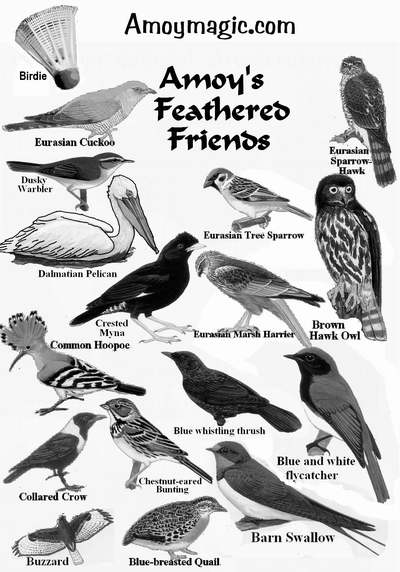
“The wily fox is the
first animal which we have to consider, for, low as he stands in the natural
series of Mammals, he is here prominent as the largest of the Carnivora
we possess…
“The greatest devastator among the poultry of the poor is an animal
belonging to the weasel family (Mustelideae),
and, though generally distributed, is very rarely seen. It measures about
a foot and a half in length, has buff-coloured fur, with a black muzzle,
and is the Hwang-shoo-lang of the Pun-ts'aou, and the Chiah-ch'oo (tawny
rat) of Amoy men…
“Before leaving the Carnaria it would be as well
to mention a curious animal that was brought alive to me by a native,
and which I kept some months in confinement. It evidently belonged to
the civet family (Viverridae), measured in
length one foot and a half, having rather long fur of a dingy brown colour,
and a black head with a white line down the snout; the tail was tipped
with white... 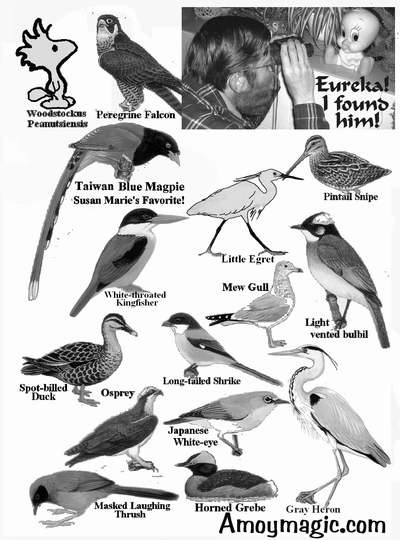
“We have also heard certain stories about the sea-otter
that is occasionally seen prowling about on Six Islands, seeking his finny
prey at the dead hour of night, and avoiding the light of day…
“…The next quadraped… is the scaly ant-eater or pangolin…Ours
is a small species (probably Manis brachyurus), measuring in toto only
two feet and three inches, of the tail takes one foot. Its gait is most
peculiar - with the body bent in a bow, and the head and tail downwards,
as it runs along on the sides of its fore feet. ..Large prices are given
by the native doctors for this animal, for its flesh and bones are employed
for various medicinal purposes; and one of its scales, fastened to the
end of a stick, is sold as a safe instrument to be used in scratching
without fear of producing ulcers on the skin. … and also the Cetacea,
the Phocaenae or porpises of which order are well known to us even in
the harbour, where at times they may be seen showing their round white
backs in a line, and then disappearing, to be seen again at a further
distance.
“… the Aves. The peregrine
falcon (Falco peregrinus) is a straggling visitor, but a pair built
their eyrie last year on the high hill of Nan-tai-woo (on the summit of
which stands the pagoda)…. A species of sparrowhawk
… There is also a buzzard (Buteo),
and the hen harrier (Circus cyaneus) of Britain
is seen not unfrequently in the early winter...An osprey
(Pandion) is sometimes seen even in the harbour, but little is known of
him. I have seen him strike a fish close under the bows of a vessel, and
bear it away in triumph.
The great owl (Bubo maximus) … A sparrow
owl (Nyctipeles, Swain.), and a small tawny Scops
owl (probably Scops rufiscens of Horsfield), are seen occasionally
in winter…
“…the blackbird and rock
thrush (Petrocincla violacea) are always with us, the former enlivening
our gardens by his rich full notes, and the latter enchanting the lonely
wanderer among the bleak hills with his wild minstrelsy, as he sings from
the summit of a monstrous boulder, or springs lightly into the air, trolling
forth his merry roundelay. It may be mentioned that the blackbird here,
though very similar, is yet not the same as our black-bird at home; he
differs not only in being of greater size, and in the colouring of the
female, but also in his call-note.
“The rock thrush and blackbird
are taken by the Chinese for one and the same, and called Ok`ee, though
one is blue and red, and the other black. The most familiar and perhaps
the best known is the magpie robin (Gryllivora),
a small bird of the pied plumage of a magpie, with the habits and peculiarities
of a robin. Its song, poured out at early morn or sunset from the roof-tops
of our houses, is occasionally pretty, but abounding in harsh and jarring
notes…
“… The most diminutive of all stands next, the little tailor-bird
(Orthotomus), remarkable for its long pointed bill, which serves as a
needle in sewing leaves together round its nest; the underside of a long
leaf of the Alpinia nutans is often chosen, the edges of which are drawn
together by thread made of spider's web and fibres. The prettiest construction
of the kind I have seen was a nest flanked in by three orange leaves,
and placed in the extremity of the boughs of an orange-tree.
“Flocks of the beautiful white egret,
or paddy bird, as they are familiarly known to us (Herodias Garzetta),
often attract our attention as they wing their way slowly through the
obscure blue of a summer twilight, from the fields where they have been
feeding, to their selected nest-trees, on which they settle like masses
of snow among the dark green leaves. The yellow-headed
egret, while with us in summer, is commoner, and roams about in
larger flocks than the latter. A third and solitary species, Herodias
flavirostris, is also found, and may be distinguished by its yellow
bill, and the tuft of snowy feathers which surmounts the occiput. We have,
besides, five or six other species of heron,
nearly all remarkable for their elegance and beauty.
“The egret is much admired by the sentimental Chinese, and is often
alluded to in poetical compositions by the style Loo-sze; and the Island
of Amoy is often poetically called Loo-mun, Loo-keang, and Loo-taon, from
the number of these snow-like birds that annually frequent it. Of the
ninety-two species of Insessores found here, nine are British birds. Seven
species of the Grallatores, and nearly all the Natatores, with the exception
of the pelicans, albatrosses,
and a few gulls and terns,
are identical with those found in Great Britain…
“ …It is unnecessary to dilate on the beauties
and delights of the study of Nature: the heart of every man naturally
throbs in the contemplation of the Creator’s handiwork, and thrills
with joy at the discovery of some new manoeuvre in the wondrous economy
which so beautifully modulates and arranges all animal and vegetable life
upon the globe.
“Solomon said, “There is nothing new under the sun; ”
so, probably, there is not; but a great deal of what passes around man
is new to him, and astonishes him when brought to his notice, simply because
he has not made use of those powers of observation that he has been endowed
with. In conclusion, I cannot do better than quote the words that Milton
puts in the mouth of the Divine Author of Nature in his address to our
first parent:-- “Is not the earth With various living creatures,
and the air, Replenish’d; and all these at thy command, To come
and play before thee?”
............................................ Robert
Swinhoe
A sampling of Swinhoe’s 174 Amoy Birds [I include some of his lengthy descriptions so you can appreciate just how serious were the birdwatchers of yesteryear. They definitely had birds on the brain!]
1. Buzzard
(Buteo vulgaris) A regular winter visitant.
2. Osprey (Pandion haliaet) Lives on the
rocks at the mouth of the harbor and comes occasionally to Amoy, but very
shy and unapproachable. I have never been able to produce a specimen.
3. Peregrine Falcon (Falco peregrinus) Breeds
in the neighbourhood and is not unfrequent.
10. Brown Hawk Owl (Ninox scutellatus) A
straggling winter visitant, common in summer at Fouchow where it breeds.
The immature plumage is brown, banded with ochraeous.
11. Great Owl (Bubo maximus) Occasionally
seen of a winter's evening. Breeds somewhere in the neighbourhood, as
every early spring the young are sold in the streets of the town.
17. Swift (Hirundapus nudipes) A straggler
in spring during rain-storms.
18. Barn Swallow (Hirundo rusticas) This
appears to be merely a degenerate variety of the European species. It
is a summer resident here and pretty numerous, building mud-nests shaped
like a half-dish, and lined with straw and a few feathers, over the doors
of Chinese huts, where they are revered as the harbingers of good luck.
19. Red-rumped Swallow (Hirundo daurica,
alpestris) A few passing flocks spend a day or two in Amoy during winter.
In Formosa it takes the place of the common species, and builds domed
nests of clay and mud under the roof-tops
21. White-throated Kingfisher (Halcyon smyrnensis)
A common resident; called “Fey-tsuy” by the Chinese, who glue
the feathers, chiefly those of the wing, over ornaments worn by their
women. Thus treated the lustrous blue feathers give the appearance of
turquoise stone. The bird is shy and remarkable for its loud screeching
cry.
24. Pied Kingfisher (Ceryle rudis) Very common
on the river; where it rises on the wing at a height above the water,
and drops suddenly on its scaly prey. I have also seen it strike obliquely
when flying close to the surface of the water.
27. Prinia (Prinia sonitans) I have named
this from the crackling noise it produces when hopping or flying from
twig to twig…
34. Dusky Warbler (Phylloscopus fuscatus)
Common during winter… its most frequent note is “chick chick.”
56. Blue Whistling Thrush (Myiophonus caeruleus)
Lives among rocky caverns; not common, and very shy; native name Aw-chuy.
64. Masked Laughing Thrush (Garrulax perspicillatuas)
Length 12 inches. Wing 4 7/10. Tail 5 2/10. Bill 9/10, to gape 1 3/10…This
large Butcher-thrush is common in some parts of the country, building
a nest a good deal like that of the Blackbird. It is a shy bird, but may
be known a long way off by its loud cry of Teo-teo, uttered from time
to time, or followed by a liquid guzzling low chatter.
65. Spectacled Thrush (Garrulax sinensis)
This is the Hwa-mei of the Chinese, by whom it is prized for its fine
vocal powers, as well as for its pugnacious propensities. It is, strictly
speaking, a hill-bird, and very abundant on the hills near Fuzhou, but
as I have, on more than one occasion, met with it in the bushes here,
I must include it in my list.
79. Long-tailed Shrike (Lanius schach) Very
common; has a great habit of shrieking. This is a much larger race than
that found in the Indian archipelago, and is no doubt worthy of specific
distinction…
82. Collared Crow (Corvus torquatus) Amoy’s
only crow.
83. Magpie (Pica media) Very common.
84. Crested Myna (Acridotheres cristatellus)
A very common species from Hongkong to Shanghai; builds in holes of trees
or walls, or makes large oval nests in trees; learns to speak with facility
and soon becomes docile.
94. Finch (Ligurinus sinicus) Half goldfinch,
half greenfinch; not uncommon all the year, has a pretty tinkling note;
and feeds on thistle-heads as well as grain, &c.
120. Little Egret (Herodias garzetta) The
common resident species; building in company on large banyan trees.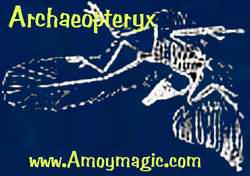
147. Goose (Anser segetum) Frequents the
mouth of the river in immense flocks during winter.
151. Spot-billed Duck (Anas poecilorhyncha)
162. Albatross (Diomedea brachyuran)
164. Mew Gull (Larus canus)
168. Loon (Gavia Kittlitzii)
173. Dalmatian Pelican (Pelecanus crispus)
Common in winter.
175. Archaeopteryx Extinct bird of the Jurassic
period. If you see one of these flying about, you’d better lay off
the rice wine.
![]() Favorite
Fujian Sites
Favorite
Fujian Sites ![]() Fujian
Foto Album
Fujian
Foto Album ![]() Xiamen
Xiamen
![]() Gulangyu
Gulangyu
![]() Fujian
Guides
Fujian
Guides ![]() Quanzhou
Quanzhou
![]() Zhangzhou
Zhangzhou
![]() Longyan
Longyan
![]() Wuyi
Mtn
Wuyi
Mtn ![]() Ningde
Ningde
![]() Putian
Putian
![]() Sanming
Sanming
![]() Zhouning
Zhouning
![]() Taimu
Mtn.
Taimu
Mtn. ![]() Roundhouses
Roundhouses
![]() Bridges
Bridges
![]() Jiangxi
Jiangxi
![]() Guilin
Guilin
![]() Order
Books
Order
Books
![]() Readers'
Letters
Readers'
Letters
Last Updated: May 2007
![]()
DAILY
LINKS
![]() FAQs
Questions?
FAQs
Questions?
![]() Real
Estate
Real
Estate
![]() Shopping
Shopping
![]() Maps
Maps
![]() Bookstores
Bookstores
![]() Trains
Trains
![]() Busses
Busses
![]() Car
Rental
Car
Rental
![]() Hotels
Hotels
![]() News
(CT)
News
(CT)
![]() Medical
& Dental
Medical
& Dental
![]() YMCA
Volunteer!
YMCA
Volunteer! ![]()
![]() XICF
Fellowship
XICF
Fellowship
![]() Churches
Churches
![]()
![]() Expat
Groups
Expat
Groups
![]() Maids
Maids
![]() Phone
#s
Phone
#s
EDUCATION
![]() Xiamen
University
Xiamen
University
![]() XIS(Int'l
School)
XIS(Int'l
School)
![]() Study
Mandarin
Study
Mandarin
![]() CSP(China
Studies)
CSP(China
Studies)
![]() Library
Library
![]() Museums
Museums
![]() History
History
DINING
![]() Restaurants
Restaurants
![]() Asian
Asian
![]() Veggie
Veggie
![]() Junk
Food
Junk
Food
![]() Chinese
Chinese
![]() Italian
Italian
![]() International
International![]()
![]() Visas
4 aliens
Visas
4 aliens
RECREATION
![]() Massage!
Massage!
![]() Beaches
Beaches
![]() Fly
Kites
Fly
Kites
![]() Sports
Sports
![]() Boardwalk
Boardwalk
![]() Parks
Parks
![]() Pets
Pets
![]() Birdwatching
Birdwatching
![]() Kung
Fu
Kung
Fu ![]() Hiking
Hiking
![]() Music
Events
Music
Events
![]() Festival&Culture
Festival&Culture
![]() Humor&
Humor&![]() Fun
Fotos
Fun
Fotos![]()
BUSINESS
![]() Doing
Business
Doing
Business
![]() Jobs!(teach/work)
Jobs!(teach/work)
![]() Hire
Workers
Hire
Workers
![]() Foreign
Companies
Foreign
Companies
![]() CIFIT
(Trade Fair)
CIFIT
(Trade Fair)
![]() MTS(Translation)
MTS(Translation)
![]()
Back to Top





